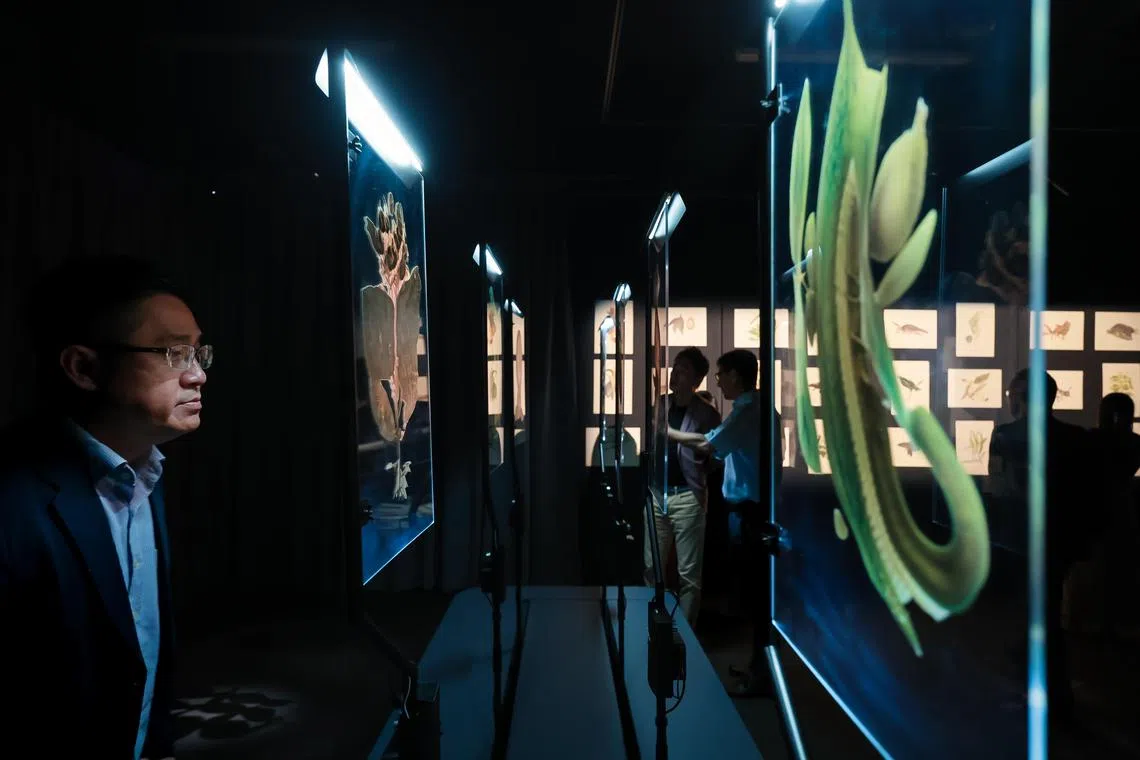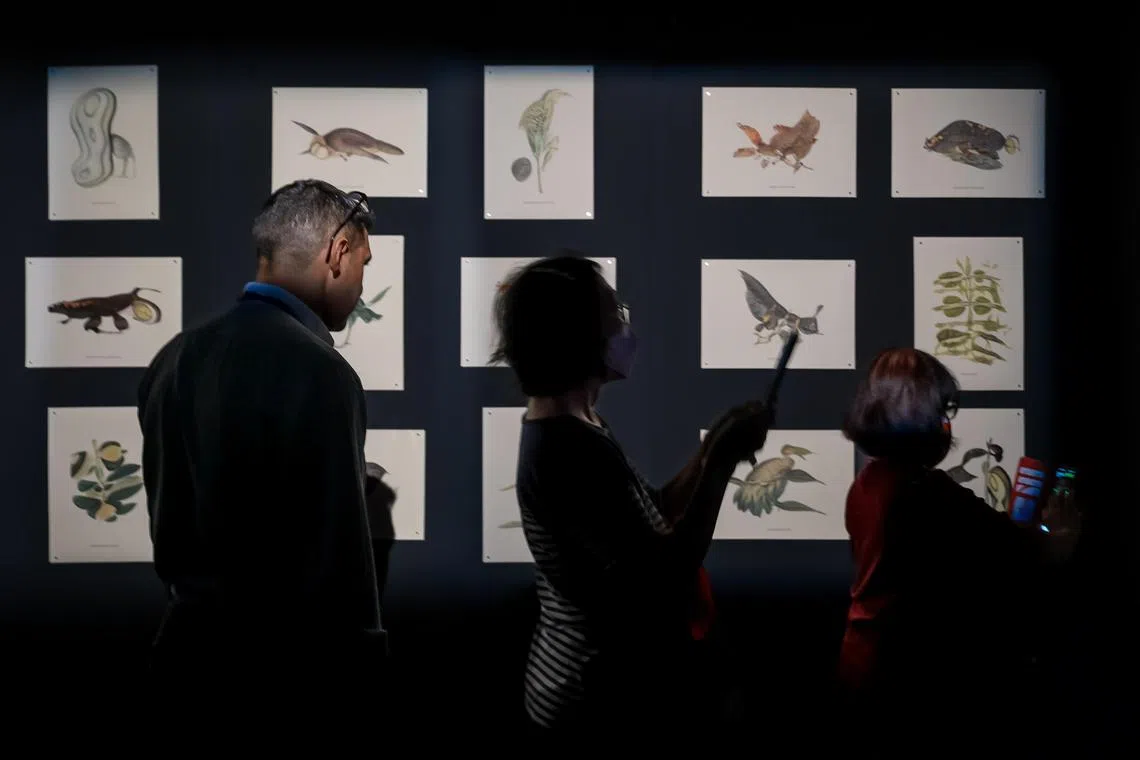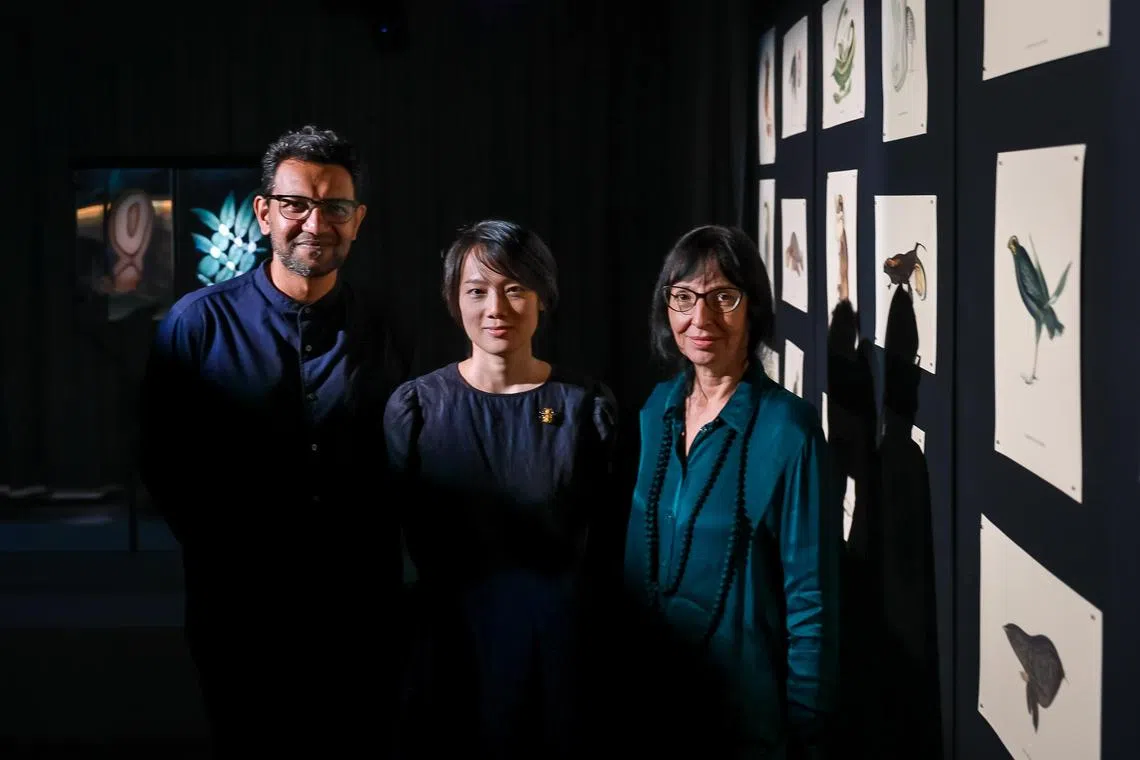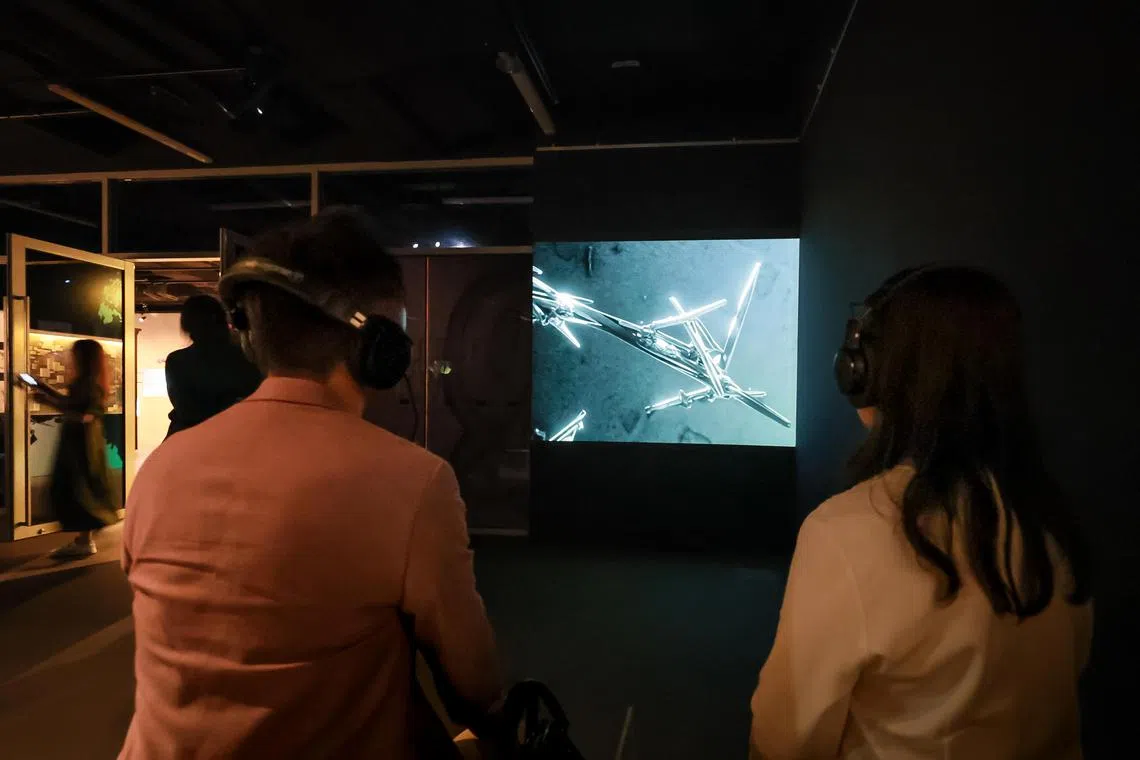New exhibition at Lee Kong Chian Natural History Museum takes creative look at nature
Sign up now: Get ST's newsletters delivered to your inbox

The exhibition showcases AI-generated images of hybrid or mutated forms of actual flora and fauna catalogued by scientists in South-east Asia during the 19th century.
ST PHOTO: GAVIN FOO
Follow topic:
SINGAPORE – A row of brightly illuminated and colourful images greets visitors to the almost pitch-black gallery on the second floor of the Lee Kong Chian Natural History Museum.
One of the images could be that of a plant – or an animal: It seems like a split-open pea pod but without peas, with a detached leaf and a few feathers, but not quite.
Accompanying the image are sounds of birds tweeting and chirping, ocean waves, rumbling thunder and the pitter-patter of raindrops.
It is difficult to identify this species without clear physical features or other characteristics.
A visitor’s instant reaction would be to refer to the usual information card found at exhibits. But there is none.
Instead, the exhibition, Nature Remixed, invites visitors to name the various new species using a QR code and to question the way organisms are classified.

The first part pf the Nature Remixed exhibition showcases AI-generated images of hybrid or mutated forms of actual flora and fauna catalogued by scientists in South-east Asia during the 19th century.
ST PHOTO: GAVIN FOO
The exhibition’s seven digital prints on acrylic and 24 prints on paper were created by artistic collective Sistrum, which comprises sound designer Ramesh Krishnan, 48; graphic designer Lim Shu Min, 35; and architect Laura Miotto, 57.
Through their artworks, they aim to invite the public to reconsider how organisms are classified and to spark discussion about it among visitors.
The trio said: “We invite and provoke visitors to give a name to the ‘speculative species’ that are the result of blurring the strict boundaries between species, genera and other taxonomic ranks.”
They added: “By presenting strange and unfamiliar species, both visually and sonically, the work asks audiences to engage in new ways of seeing and hearing, to observe and to listen closer.”

Visitors are invited to name the various new species using a QR code.
ST PHOTO: GAVIN FOO
Sistrum used artificial intelligence (AI) to generate images of hybrid or mutated forms of actual flora and fauna catalogued by scientists in South-east Asia during the 19th century.
The images are accompanied by modified audio samples of sounds recorded in nature.
Associate Professor Darren Yeo Chong Jinn, head of the museum, said at the launch of the Nature Remixed exhibition on May 20: “This unique interaction between art and science will invite us all – scientists, artists, lay people – to question our own perceptions of species.”

The Sistrum team of (from left) sound designer Ramesh Krishnan, graphic designer Lim Shu Min and architect Laura Miotto at their Nature Remixed exhibition at Lee Kong Chian Natural History Museum.
ST PHOTO: GAVIN FOO
Nature Remixed, which is being held at the museum till July 28, blurs the line between science and art, unlike many other exhibitions, which focus on one or the other.
Sistrum said the artworks in the exhibition involved the use of generative AI, as well as generating images using scanning electron microscopy and manipulating natural sound recordings using electronic technology.
The second part of the exhibition is an audio-visual animation lasting over six minutes that is played on a screen measuring approximately 2m by 1.5m. It is composed of highly magnified images of specimens taken from marine sponges – morphing from one image to another – and incorporates hypnotic and relaxing sounds.
The animation expands the still images obtained from a scanning electron microscope using movement. It is a multisensory experience which lets visitors travel into an unknown and invisible territory and fuels their imagination, Sistrum added.
This offers museum-goers “a glimpse into a world invisible to the naked eye and (invites them) to connect to these living forms which are unknown to most of us”.

Guests watching an audio-visual animation titled Filtering Microworlds, composed of highly magnified images of specimens taken from marine sponges that were captured with Hitachi’s tabletop electron microscope.
ST PHOTO: GAVIN FOO
The black-and-white images highlighting the inner structure of the sponges – usually made up of calcium carbonate, silica and a protein called spongin – were taken with Hitachi’s tabletop scanning electron microscope by the trio.
Unlike optical microscopes which are commonly used in schools and use visible light, electron microscopes focus beams of electrons on specimens. A detector is then used to catch the electrons that have been reflected, passed through and bounced around the specimen, before the collected information is projected as an image on a computer screen.
Images produced by electron microscopes are of a higher resolution and show more details, compared with those captured by optical microscopes.

Mr Hidehiro Yamada, managing director of Hitachi High-Tech Malaysia, with Hitachi’s TM4000Plus II tabletop scanning electron microscope at the preview of the Nature Remixed exhibition.
ST PHOTO: GAVIN FOO
Hitachi’s TM4000Plus II tabletop scanning electron microscope – which is on loan from Hitachi to the museum for a year from January – can magnify specimens up to 100,000 times, compared with optical microscopes, which can magnify specimens up to only 2,000 times.
Also announced at the launch was a collaboration between Hitachi and the museum to engage students through the museum’s science initiatives.
The initiatives include a new biodiversity outreach workshop which will offer local secondary and tertiary students hands-on experience with the electron microscope to study the outer coverings of animals such as sharks, pythons, sea stars and owls.
The museum will also conduct a public programme, Secrets Of Extraordinary Microworlds, which will give participants the opportunity to explore the microscopic features of different specimens with the electron microscope.
Sessions will run from May 30 to June 22.
In addition to these programmes, the collaboration between Hitachi and the museum allows the museum’s researchers and their collaborators to use the electron microscope for taxonomic work, undergraduate teaching and student-initiated projects.
Admission to the museum, Nature Remixed and permanent galleries costs between $10 and $27.

